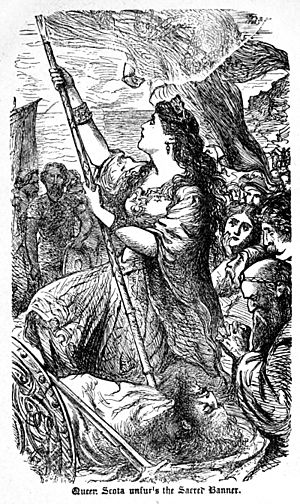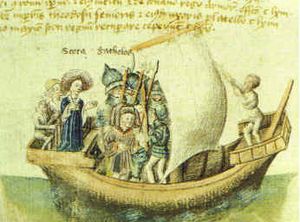Scota facts for kids
In old Irish and Scottish stories, Scota (sometimes called Scotia) is a legendary princess from Ancient Egypt. People believed she was the ancestor of the Gaels, who are the ancestors of the Irish and Scottish people. The name Scoti (a Latin word for the Gaels) was thought to come from her. However, historians today believe Scota and her family were just characters in myths. They were likely created to explain the name "Scoti" and to give the Gaels a long, interesting history.
Contents
Who Was Scota in Early Legends?
The first time Scota is mentioned in writing is in the 12th century. She appears in an old Irish book called the Book of Leinster. This book includes a version of the Lebor Gabála Érenn, which is a collection of Irish myths.
In some versions of the Lebor Gabála Érenn, Scota is the mother of Goídel Glas. Goídel Glas is considered the main ancestor of the Gaels. This Scota was said to be the daughter of an Egyptian pharaoh named Cingris. This pharaoh's name is only found in Irish legends. Scota married a man named Niul. Niul was a scholar from Babylonia who traveled to Egypt.
Their son, Goídel, was said to have created the Gaelic language. He supposedly combined the best parts of 72 different languages. Another story says that Goídel was saved by a prayer from Moses after being bitten by a snake.
Different Stories About Scota
Other stories from the 12th century say that Scota was the wife of Goídel Glas, not his mother. In these tales, Scota and Goídel Glas led the Scots and Gaels after they left Egypt.
Another legend in the Lebor Gabála Érenn says there was a different Scota. This Scota was the wife of Míl Espáine, who was a descendant of Goídel. Míl Espáine came from ancient Iberia (modern-day Spain and Portugal). Her burial place, called Scotia's Grave, is a famous spot in Ireland.
Historians explain that characters like Goídel and Scota were likely invented. They helped explain the names Goídel (Gaelic) and Scoti (Latin) and fit the Gaels into a grand historical story.
Scota and the Stone of Scone
The Stone of Scone is a very important stone in Scottish history. It was used for the coronations (crowning ceremonies) of Scottish kings. In 1301, a man named Baldred Bisset connected the Stone of Scone to the Scota legends. He claimed that Scotland, not Ireland, was Scota's original homeland.
Bisset wanted to show that Scotland had a strong claim to its own king. When Alexander III of Scotland died in 1286, there was a question about who should be the next king. At his own crowning in 1249, Alexander III had heard his family tree traced all the way back to Scota.
Bisset's story said that Scota brought the Stone of Scone from Ancient Egypt to Scotland. She supposedly did this during the time of the Exodus of Moses. In 1296, the Stone was taken by Edward I of England and moved to England. Later, in 1323, Robert the Bruce used Bisset's legend to try and get the Stone back to Scotland.
Other Stories About Scota
Many other old books and chronicles mention the Scota legends. These include:
- Orygynale Cronykil of Scotland by Andrew of Wyntoun
- Chronica Gentis Scotorum (1385) by John of Fordun
- Scalacronica (1362) by Thomas Grey
- Historia Gentis Scotorum by Hector Boece (16th century)
The Scotichronicon by Walter Bower (15th century) even included the first pictures of these legends.
Scota's Grave
"Scota's Grave" is a rocky area in Gleann Scoithín, or 'Glenscoheen'. It is located south of Tralee in County Kerry, Ireland. People believe this is where the legendary Scota was buried. However, after looking at the site in 1999, experts decided there wasn't enough proof to say it was an actual ancient monument.
Images for kids
See also
- Scotia
- Šērūʾa-ēṭirat




